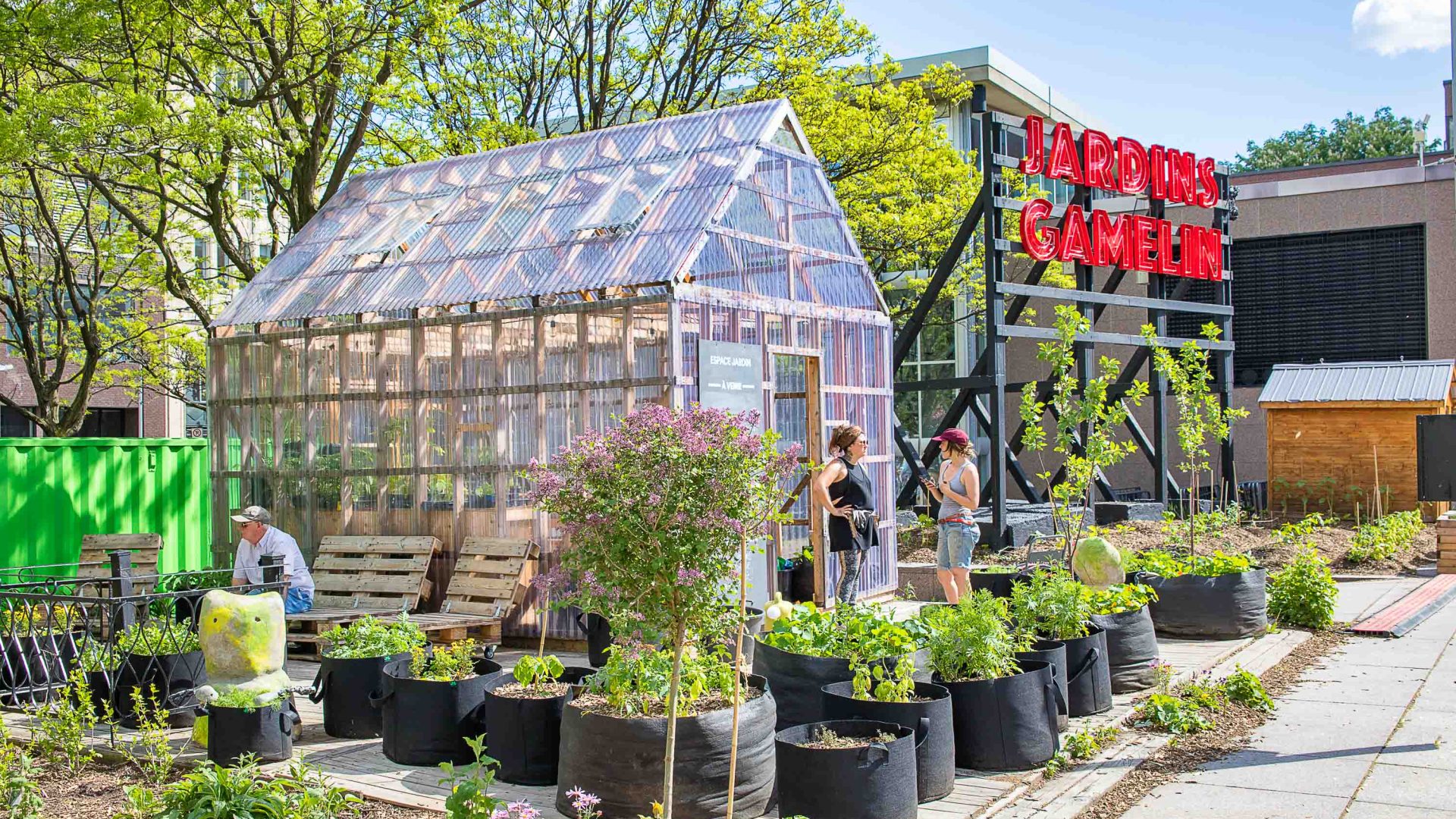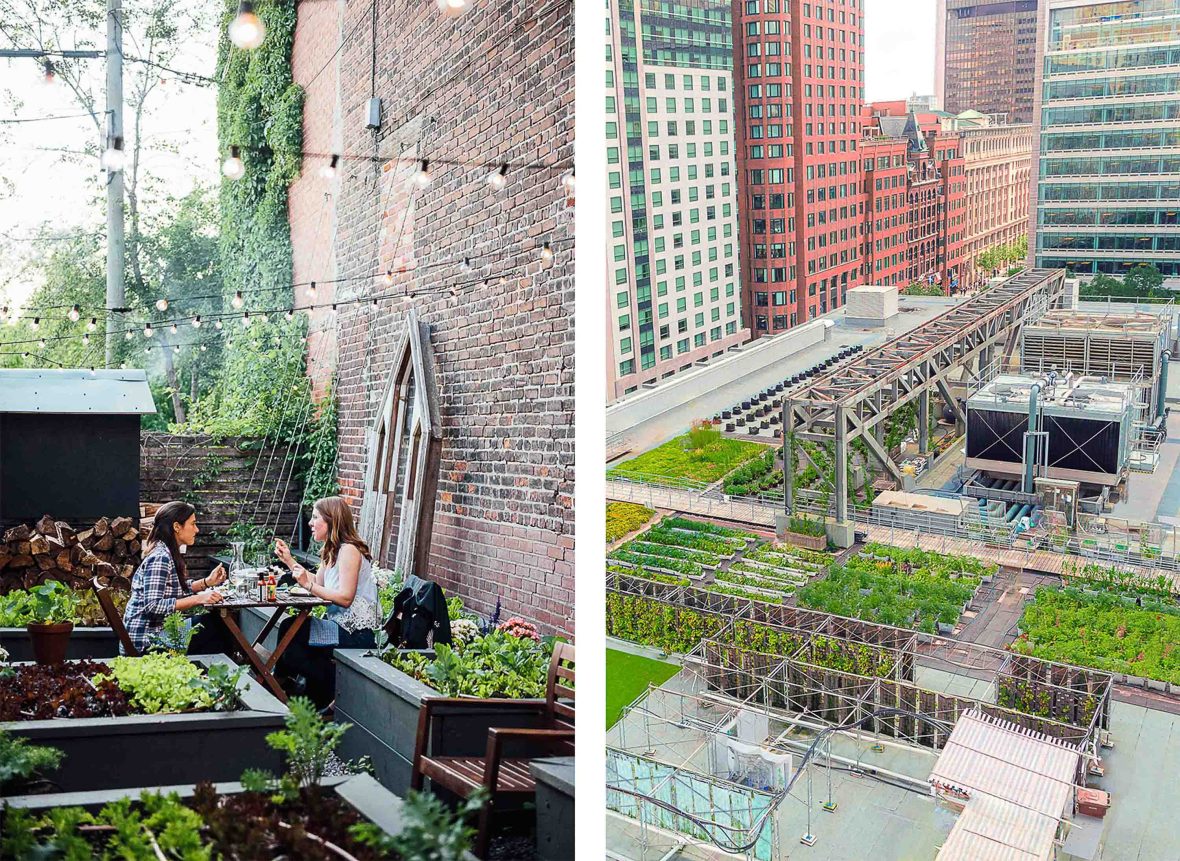
Montréal is already known as Canada’s gourmet city—with world-renowned restaurants and chefs gracing its streets. But behind this fine-dining exterior is an urban farm movement that could help shape the future of sustainable urban living.


Montréal is already known as Canada’s gourmet city—with world-renowned restaurants and chefs gracing its streets. But behind this fine-dining exterior is an urban farm movement that could help shape the future of sustainable urban living.
Standing on the rooftop of a converted warehouse in the Ahuntsic-Cartierville neighborhood on the north fringe of Montreal, once the center of Montréal’s textile industry, I feel a little bit like Batwoman. Except, instead of surveying the streets below for crime, I am looking at an urban vineyard. In fact, it’s Canada’s first urban rooftop vineyard: Rows of vines of the local Québec variety that are resilient to cold and wind, grown in bags made of felt.
“These are a rustic and cold resistant variety of grapes called Frontenac,” explains Kevin Drouin-Léger, the coordinator of La Centrale Agricole, the world’s largest urban agriculture cooperative whose rooftop we’re on. “We make wines combining these grapes with grapes from other rooftop locations.”
Montréal is home to Canada’s first urban rooftop vineyard, and is a designated world capital of urban farming. It’s in places like this, up on rooftops, deep in its basements, and inside derelict warehouses where Montréal harbors a secret to the future of sustainable city living: A thriving urban agriculture network.
Supplying the city’s legendary cafés and restaurants with fresh produce, it’s down to these urban farms that establishments are proudly serving high-quality and locally sourced food and wine—and it’s these same urban farms stocking Montréal’s many markets such as Atwater Market on the Lachine Canal and Jean Talon Market at Little Italy.
It’s not just vines. Melons, leafy vegetables, tomatoes and so much more are grown when in-season—an effective use of dead space. “This rooftop produces eight tonnes of food in an area around 12,000 square feet,” Kevin tells me. “The gravel and tar of the roof generate a lot of heat in summer, so we can plant vegetable and fruit varieties that are frost-resistant to start, as well as those that thrive in the summer heat.”
And this is just one player in Montréal’s growing urban agriculture scene which includes at least 270 organizations, including 57 urban farms, and numerous community garden initiatives.
“Ah, we are in Québec. Almost all our energy generated is renewable hydro-power. So in a way, it is the perfect place for urban farming.”
- Kevin Drouin-Léger, La Centrale Agricole
In the past decade, urban agriculture as a concept has been highly recommended by the UN Environment Programme (UNEP) and the World Bank as a way to combat the issue of food security in highly urbanized areas. In a report titled Urban Agriculture’s Potential to Advance Multiple Sustainability Goals, the UNEP states that “urban agriculture can help feed people in cities and alleviate the triple planetary crises of climate change, nature and biodiversity loss, and pollution and waste.”
Rapid urbanization is a big contributor to loss of land for farming, and to deforestation, as this UN report states. And with 55 percent of the world’s population currently living in urban areas, and expected to rise 68 percent by 2050, bringing agriculture into the urban environment has never felt more timely. With improved processes to produce better quality food, urban farming has the potential to alleviate the consequences of its nemesis: Mass food production.
The cooperative occupies most of the building, and, floor by floor, we check out some of the other members; among them, a cidery, a winery, an apiary, and a business that grows mealworms, a less resource-intensive protein food source than livestock. According to the World Economic Forum, “Industrializing their production and consumption could open up new routes to feeding the world’s growing population and alleviating some of the environmental pressures caused by conventional agriculture.”
There are 17 different businesses located in the one building—and you needn’t fret the power bill from all this farming, either. “Ah, we are in Québec,” Kevin says. “Almost all our energy generated is renewable hydro-power. So in a way, it is the perfect place for urban farming.”
Organizations such as La Centrale Agricole are researching ways to improve and generate products to supply the growing urban population, with food insecurity, a huge global concern. The World Bank warns that the world’s food production and distribution is under threat from climate change, conflicts and poverty.
Conventional agriculture is land-exhausting, degrades soil quality, and requires large amounts of water, hence the need for alternatives. The UNEP believes that development in urban agriculture can alleviate the “triple crises of climate change, biodiversity loss and pollution”.
So with the right planning and technology, not only can urban agriculture use otherwise-wasted space and rooftops, it can also recycle industrial by-products such as heat, water and organic compost, in turn creating new jobs and social integration. It’s the circular economy in action; addressing food security and sustainability issues in our major cities.

A few blocks away on the other side of the Garment District, Georges Aczam is waiting for me at Les Fermes AquaVerti, Quebec’s first indoor hydroponic (soil-free) farm. Like many other urban producers, AquaVerti is housed in a warehouse, but behind its discreet entrance is a world of technologically advanced farming.
Originally from Syria, Georges came to Montréal to study and never left. But it was his data-driven finance background that inspired him to use technology to collect information from his farm to improve and control the environment. And that innovation is evident here. Among seven vertical and horizontal layers of hydroponic fields—AquaVertia is a vertical farm, hence the name—this production space of 15,000 square feet is growing salads, herbs, rhubarb and leafy vegetables such as cabbages and kale, and supplying supermarkets and open-air markets across Québec province.
Georges saw an opportunity to use his knowledge and passion, and started AquaVerti in 2018. The first two years were used to build a foundation, and he invested into production research using smart data—such as light frequency, oxygen levels, and the humidity collected from his plants—to determine the optimal environment each food variety would need to grow at its best. By 2020, during the pandemic, he was ready to go to market.
Studies by Potsdam Institute for Climate Impact Research indicates by replacing as few as 20 percent of red meat intake with microbial protein could halve the rate of deforestation and carbon emission by 2050.
“Covid was a catalyst that opened the government’s eyes to food security,” he says as he shows me around. “At any time if food production stopped in the world, we only have enough fresh veg and fruit to last the city 48 hours.”
And that’s the underlying motivation. Urban agriculture is offering residents locally grown produce, reducing the cost of logistics, and while not always cheaper, offering better quality. “Compared to traditional field farming, we’re able to control the environment and improve quality and yield to guarantee food security,” he says, picking up a head of lettuce for me to taste. It’s fresh and crisp, as expected. I look around to inspect a row of arugula and smile at the sight of ladybugs crawling between plants.
“Ah, my little soldiers!” says Georges. “While we can control the light and humidity, we maintain a natural process with all other aspects of farming, such as using ladybugs as pest control instead of using chemicals.”
Closer to Downtown Montréal, my tour continues: More warehouse spaces, more opportunities for food production. Les 400 Pieds de Champignon (400 Feet of Mushrooms) is another self-starter company, growing quality mushrooms and supplying some of the top restaurants and the markets.
Mushrooms contain microbial protein that can easily replace much of the protein intake from meat. In fact, studies by Potsdam Institute for Climate Impact Research indicates by replacing as few as 20 percent of red meat intake with microbial protein could halve the rate of deforestation and carbon emission by 2050.
“Five years ago, we started with 400 square feet, hence the name, and now we have 6,000 square feet of space, producing one tonne of nine varieties of mushrooms per week,” says company co-founder Mickael Loyer, as he shows me around the rooms used for different stages of mushroom production.
For urban consumption, mushrooms do make a lot of sense. This nutritious fungus is relatively easy to grow, doesn’t require a lot of space, and has multiple harvest periods during the year.
Mickael leads us from one chilled room to another, showing off his funghi, from shitake to oyster to king mushrooms. “Annoyingly, we are in constant battle against mould,” he says. “It isn’t harmful to the mushrooms or us, but the mould competes against the mushrooms for the space, and you end up with less mushrooms!”
Later at dinner, I scan the menu at Foxy Restaurant in the trendy Griffintown neighborhood, by the historic Lachine Canal southwest of the city. On the first page is a listing of suppliers of fresh ingredients: Half are listed from Montréal, and all listed from the Québec province.
“It’s almost like zero-kilometer dining,” the bartender says, as he tells us that day’s specials. “We are really supportive of our local producers. It is always better to buy from them as much as possible, instead of importing from somewhere else.”
In Montréal, ‘farmers’ are genuinely working towards a future where food can be locally grown and sourced, against the more challenging backdrop of inner city life. Supported by the government, it all feeds into Montréal’s Climate Plan 2020-2030 which appears hopeful for a genuinely sustainable urban environment. Encouraging innovators and entrepreneurs to consider food production methods that reduce transportation emissions and minimize land loss may not be easy in a world of increased consumption, but it’s happening here. It’s certainly something to shout about, from the rooftops and beyond.
**
Visitors to Montréal can tour the urban farms with Origine Québec. The writer was a guest of Tourisme Montréal and Air Transat.
****
Adventure.com strives to be a low-emissions travel publication. We are powered by, but editorially independent of, Intrepid Travel, the world’s largest travel B Corp, who help ensure Adventure.com maintains high standards of sustainability in our work and activities. You can visit our sustainability page or read our Contributor Impact Guidelines for more information.

Amy McPherson is a travel writer whose heart follows the wild outdoors, especially on a trail in the mountains, and she never misses a chance to get on a bike on her travels. Her features appear in Australian and UK publications, such as Italia!, The Good Life France and escape.com.au.








Can't find what you're looking for? Try using these tags: